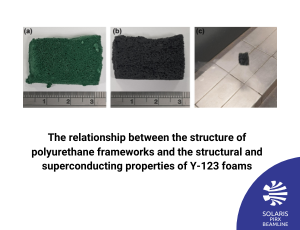
A Polish team of researchers led by Dr. Paweł Pęczkowski from the Institute of Physical Sciences, Faculty of Mathematics and Natural Sciences, Cardinal Stefan Wyszyński University used the PIRX beam to study the properties of the electronic structure of superconducting foams obtained on the basis of polyurethane foams. The research results were published in the Journal of the European Ceramic Society published by Elsevier.
High-temperature superconductors (HTS) are most often produced in one of three varieties - thin film, wire (tape) and loose. This division results from the properties of these superconductors, which originate from their microstructure. High-temperature superconductors can be produced in a fourth variant with a foam structure. Superconductors with a foam structure have a much shorter cooling time, so the transition or return to the superconducting state from the normal state is much faster than in the case of solid samples manufactured using the top-seeded infiltration-growth (TSIG) method. Additionally, they are lightweight and exhibit fewer micro-cracks, which are the main factor limiting the critical current density in solid superconducting samples. These unique features make superconducting foams an excellent material for space applications, where it is necessary to use strong and light sources of magnetic fields to build, for example, docking mechanisms for space vehicles and ion engines. However, before superconducting foams are used, several basic questions need to be answered: what is the impact of changes in the foam structure (e.g. size and shape of pores) on superconducting properties, how does current flow in the three-dimensional structure of the foam and what is its impact on the properties related to ability to anchor vortexes (pinning centers).
In the TSIG process, precursor foams (polyurethanes with various densities, flexibilities, and skeleton types) were infiltrated with a green phase (Y-211) and thermally converted to Y-123 superconductors using NdBCO single-crystal seeds oriented in the [100] direction (Figure 1). A set of polyurethane foams that served as a framework for the production of superconducting foams was provided by "JAG" Production and Trade Enterprise Company - a leading polyurethane foams manufacturer in Poland. A series of polyurethane foams with different skeletons and different mechanical properties were carefully selected. Sample designations were as follows: T-18/30)p, (T-25/38)p, (T-30/42)p, (T-35/38)p, (T-40/50)p, ( HR-30/38)p, (CL-25/33)p, and Melamine foam with different pore densities and the ratio of wall thickness to pore size, where the letter symbols mean: T - upholstery foams, HR - highly flexible foams and CL - flame-retardant foams, and the entered values correspond to the key parameters of the foam as density in kg / m3 (first number ) and elasticity in kPa (second number). The index "p" denotes the polyurethane structure of the foam.

Figure 1. (a) Y-211 foam before and (b) after Y-035 infiltration process; (c) Y-123 - final foam levitation in a magnetic field
In Y-123 foams obtained in the TSIG process, the existence of superconducting phase was confirmed by X-ray diffraction (XRD), Raman spectroscopy and X-ray absorption spectroscopy (XAS), as well as magneto-metric and transport investigation. It was found that the growth of Y-123 foam preserves the crystallographic direction of the NdBCO nucleation agent regardless of the initial orientation of the skeleton. The foams exhibit the critical temperature similar to loose YBCO. High-density and stiffness skeletons favour the Y-123 phase formation, while more flexible foam structures hamper the transformation of the Y-211 phase into the Y-123 one.
X-ray absorption spectra (XAS) for selected foams are shown in Figure 2. XAS data were obtained at the PIRX beamline at the SOLARIS National Synchrotron Radiation Centre in Krakow (Poland). The oxygen K-edge is characterized by a distinct absorption at 533 eV with several pre-peaks in the 527 ‒ 529 eV range, originating from the hybridization of the O-2p and Cu-3d orbitals. The O K-edges provide information about the carrier mobility in the CuO2 planes and Cu‒O chains. A contribution of two distinct pre-peaks, a wide one at 527.5 eV and a more narrow one at 528 eV, is characteristic of CL-25/33 and T-40/50. The former pre-peak is related to chain holes (CH) and Zhang-Rice singlets (ZRS), while the latter is the so-called upper Hubbard band (UHB). Moreover, the superconductivity of cuprates is emphasized by a significant ZRS contribution concerning UHB, which is for CL-25/33, T-40/50, and partly for T-30/42 foams.

Figure 2. X-ray absorption spectra (XAS) for Y-123 foams (T-18/30, T-30/42, T-40/50, CL-25/33 i Melamine): (a) O K-edge, (b) Ba M4,5-edges, (c) Cu L2,3- edges. CH - chain holes, ZRS - Zhang-Rice singlet, UHB - upper Hubbard band
Author: Paweł Pęczkowski
Link to the publication: P. Pęczkowski, P. Zachariasz, R. Zalecki, J. Piętosa, J.M. Michalik, C. Jastrzębski, M. Ziętala, Ł. Gondek, Influence of poliurethane skeleton on structural and superconducting properties of Y-123 foams, Journal of the European Ceramic Society (2024), doi:10.1016/j.jeurceramsoc.2024.03.039.
Published date 16/04/2024
- Dagmara Chylewska-Olech

 Web Content Display
Web Content Display
 Web Content Display
Web Content Display
 Web Content Display
Web Content Display
